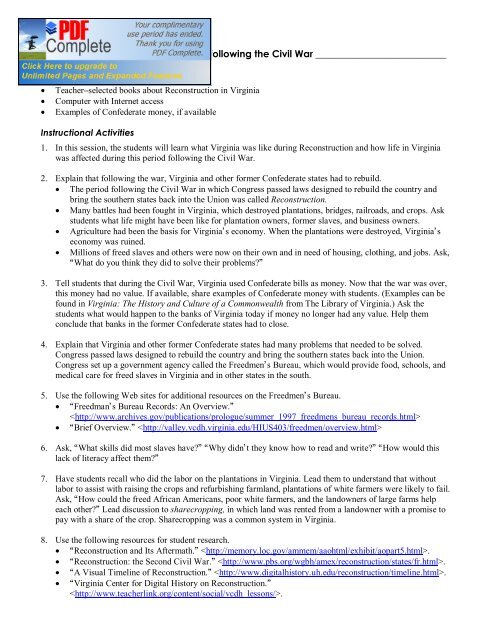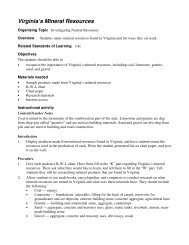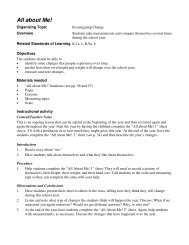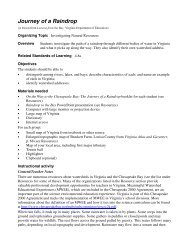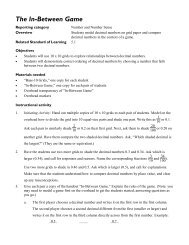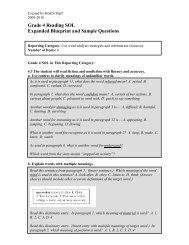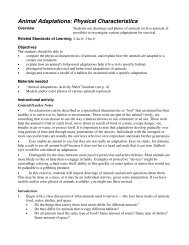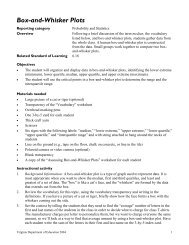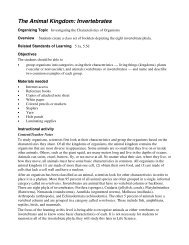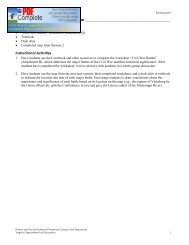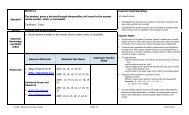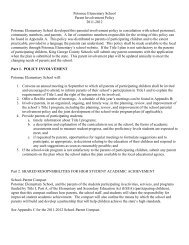Session 3: Reconstruction in Virginia following the Civil War
Session 3: Reconstruction in Virginia following the Civil War
Session 3: Reconstruction in Virginia following the Civil War
You also want an ePaper? Increase the reach of your titles
YUMPU automatically turns print PDFs into web optimized ePapers that Google loves.
Virg<strong>in</strong>ia Studies<br />
<strong>Session</strong> 3: <strong>Reconstruction</strong> <strong>in</strong> Virg<strong>in</strong>ia follow<strong>in</strong>g <strong>the</strong> <strong>Civil</strong> <strong>War</strong> ___________________________<br />
Materials<br />
· Teacherselected books about <strong>Reconstruction</strong> <strong>in</strong> Virg<strong>in</strong>ia<br />
· Computer with Internet access<br />
· Examples of Confederate money, if available<br />
Instructional Activities<br />
1. In this session, <strong>the</strong> students will learn what Virg<strong>in</strong>ia was like dur<strong>in</strong>g <strong>Reconstruction</strong> and how life <strong>in</strong> Virg<strong>in</strong>ia<br />
was affected dur<strong>in</strong>g this period follow<strong>in</strong>g <strong>the</strong> <strong>Civil</strong> <strong>War</strong>.<br />
2. Expla<strong>in</strong> that follow<strong>in</strong>g <strong>the</strong> war, Virg<strong>in</strong>ia and o<strong>the</strong>r former Confederate states had to rebuild.<br />
· The period follow<strong>in</strong>g <strong>the</strong> <strong>Civil</strong> <strong>War</strong> <strong>in</strong> which Congress passed laws designed to rebuild <strong>the</strong> country and<br />
br<strong>in</strong>g <strong>the</strong> sou<strong>the</strong>rn states back <strong>in</strong>to <strong>the</strong> Union was called <strong>Reconstruction</strong>.<br />
· Many battles had been fought <strong>in</strong> Virg<strong>in</strong>ia, which destroyed plantations, bridges, railroads, and crops. Ask<br />
students what life might have been like for plantation owners, former slaves, and bus<strong>in</strong>ess owners.<br />
· Agriculture had been <strong>the</strong> basis for Virg<strong>in</strong>ias economy. When <strong>the</strong> plantations were destroyed, Virg<strong>in</strong>ias<br />
economy was ru<strong>in</strong>ed.<br />
· Millions of freed slaves and o<strong>the</strong>rs were now on <strong>the</strong>ir own and <strong>in</strong> need of hous<strong>in</strong>g, cloth<strong>in</strong>g, and jobs. Ask,<br />
What do you th<strong>in</strong>k <strong>the</strong>y did to solve <strong>the</strong>ir problems?<br />
3. Tell students that dur<strong>in</strong>g <strong>the</strong> <strong>Civil</strong> <strong>War</strong>, Virg<strong>in</strong>ia used Confederate bills as money. Now that <strong>the</strong> war was over,<br />
this money had no value. If available, share examples of Confederate money with students. (Examples can be<br />
found <strong>in</strong> Virg<strong>in</strong>ia: The History and Culture of a Commonwealth from The Library of Virg<strong>in</strong>ia.) Ask <strong>the</strong><br />
students what would happen to <strong>the</strong> banks of Virg<strong>in</strong>ia today if money no longer had any value. Help <strong>the</strong>m<br />
conclude that banks <strong>in</strong> <strong>the</strong> former Confederate states had to close.<br />
4. Expla<strong>in</strong> that Virg<strong>in</strong>ia and o<strong>the</strong>r former Confederate states had many problems that needed to be solved.<br />
Congress passed laws designed to rebuild <strong>the</strong> country and br<strong>in</strong>g <strong>the</strong> sou<strong>the</strong>rn states back <strong>in</strong>to <strong>the</strong> Union.<br />
Congress set up a government agency called <strong>the</strong> Freedmens Bureau, which would provide food, schools, and<br />
medical care for freed slaves <strong>in</strong> Virg<strong>in</strong>ia and <strong>in</strong> o<strong>the</strong>r states <strong>in</strong> <strong>the</strong> south.<br />
5. Use <strong>the</strong> follow<strong>in</strong>g Web sites for additional resources on <strong>the</strong> Freedmens Bureau.<br />
· Freedmans Bureau Records: An Overview.<br />
<br />
· Brief Overview. <br />
6. Ask, What skills did most slaves have? Why didnt <strong>the</strong>y know how to read and write? How would this<br />
lack of literacy affect <strong>the</strong>m?<br />
7. Have students recall who did <strong>the</strong> labor on <strong>the</strong> plantations <strong>in</strong> Virg<strong>in</strong>ia. Lead <strong>the</strong>m to understand that without<br />
labor to assist with rais<strong>in</strong>g <strong>the</strong> crops and refurbish<strong>in</strong>g farmland, plantations of white farmers were likely to fail.<br />
Ask, How could <strong>the</strong> freed African Americans, poor white farmers, and <strong>the</strong> landowners of large farms help<br />
each o<strong>the</strong>r? Lead discussion to sharecropp<strong>in</strong>g, <strong>in</strong> which land was rented from a landowner with a promise to<br />
pay with a share of <strong>the</strong> crop. Sharecropp<strong>in</strong>g was a common system <strong>in</strong> Virg<strong>in</strong>ia.<br />
8. Use <strong>the</strong> follow<strong>in</strong>g resources for student research.<br />
· <strong>Reconstruction</strong> and Its Aftermath. .<br />
· <strong>Reconstruction</strong>: <strong>the</strong> Second <strong>Civil</strong> <strong>War</strong>. .<br />
· A Visual Timel<strong>in</strong>e of <strong>Reconstruction</strong>. .<br />
· Virg<strong>in</strong>ia Center for Digital History on <strong>Reconstruction</strong>.<br />
.
Virg<strong>in</strong>ia Studies<br />
· Becom<strong>in</strong>g New Sou<strong>the</strong>rners. .


